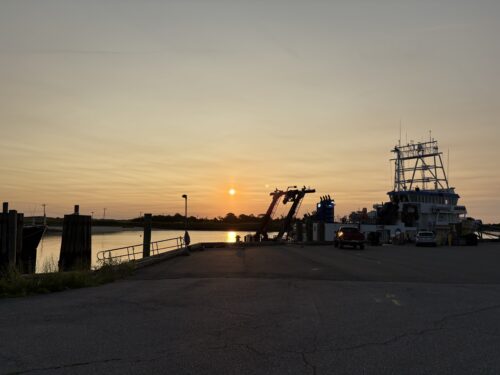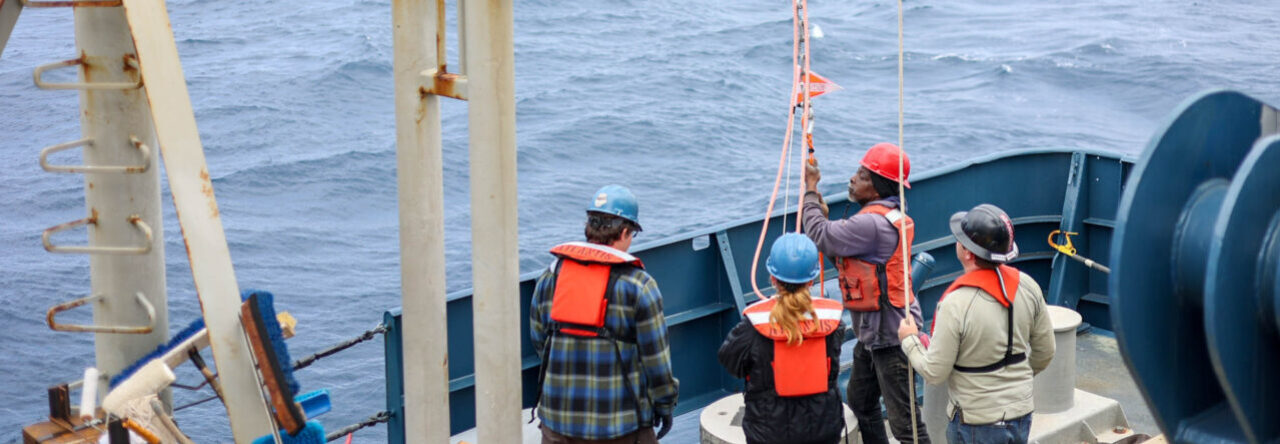Hello readers,
I have completed my first week on the Hugh R. Sharp. My mentor was kind enough to have me come a week in advance of the planned missions to help ease me onto the vessel. This week, I learned and assisted with the remaining general maintenance tasks that marine techs must complete before mobilization.
I loved my mentor’s teaching method. He understood that real skill is built through action. From the first day, rather than feeling like an intern, I felt like I was working on the ship and was part of the crew.

A Brief Day in the Life
Since we are still at port, every day I would wake up at 4 am to go to the gym with a crew member roughly my age. We would get back at 6:30 am to eat and get ready for our work day. The day would start roughly at 7 am, and it almost always began with discussing a brief plan for the day. We would have to coordinate with others to formulate our daily plans, sometimes making material orders or checking on part fabrication orders. Once the day was done, I would usually shower, then relax and go to sleep.
First Work Day
From the first day, my mentor allowed me to take an active role.
I spent the first half of my Tuesday touring the facilities and meeting the crew. The second half of the day, I was between a cable spool and a cable-level management system (Caley). I was adjusting, loosening tension, or cutting the slack of wires as needed to ensure the Caley had its full range of motion while having a clean-looking wire management. Once I completed that job, I became a tool fetcher for the engineers of the vessel for the remainder of the day. The engineers needed to complete their checks before we could continue with the tech’s responsibilities.
The Rest of the Days
Shortly after, I was notified that our first mission would be canceled and replaced with a Sea Trial. The University that was originally scheduled had a conflict and was unable to make it.
On Wednesday, I did more wire management. It was a multiple-person job, as one person had to be on the bridge, carefully pulling the individual wire up to spool it, and the other had to signal when to stop pulling and hold the wires in place.

In the latter half of the day, I did a mechanical CTD cable termination under the supervision of my mentor. There are multiple phases to the mechanical portion of the cable termination, one of the last was pouring molten aluminum to secure the cable, and then tension testing our mechanical connection.

On Thursday, I did the electrical portion of the CTD cable termination. This includes stripping the wire casing, then color coding and crimping the wire ends together. I got to use special wire crimper connectors that used solder, helping waterproof the connections. Once the connections were made, we encased them with scotch cast using a mold. The remaining portion of the electrical work is to connect the cable to the CTD.

At the end of Thursday, we needed to get the Caley stats computer (showing stats like tension on the cable) to display its information on the main computer. This would make it easier for the people on the bridge operating the Caley. We found the supposed IP address and Port Number, but we could not get it to connect to the master display software of the main computer. Thus, I thought to look up command prompts to show IP addresses that the main computer can detect. Once I used the command netstat -ano, and saw that the Caley Stats Computer IP was not detected. From this result, I knew either the Ethernet cable was not plugged in all the way at the Ethernet switch, or the IP address was wrong. Luckily, it was the Ethernet cord not being plugged in at the switch.
Friday was a half-day, the marine techs and I went to a couple of places and stores to pick up a custom transducer mount and other materials that we will need.
Conclusion
The whole crew is extremely nice and fun, and helped me have an amazing first week! On Monday, the 9th, we will start mobilization for the Sea Trial. I cannot wait to learn even more during this upcoming week!



